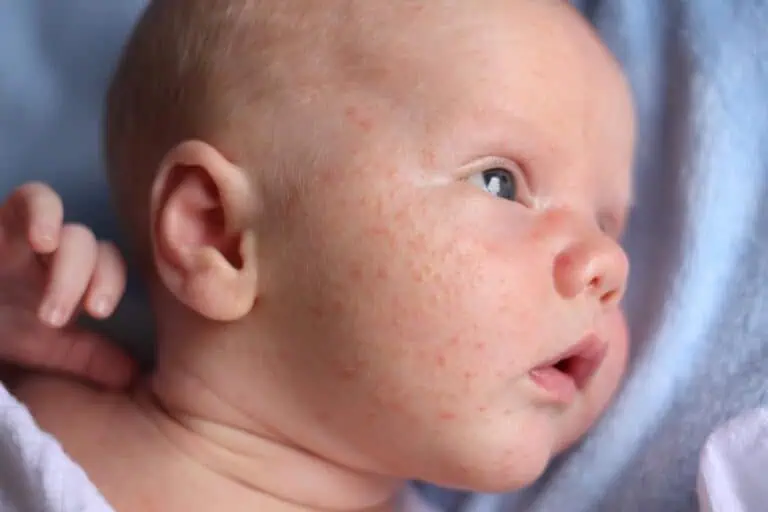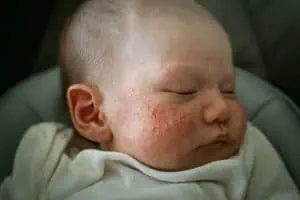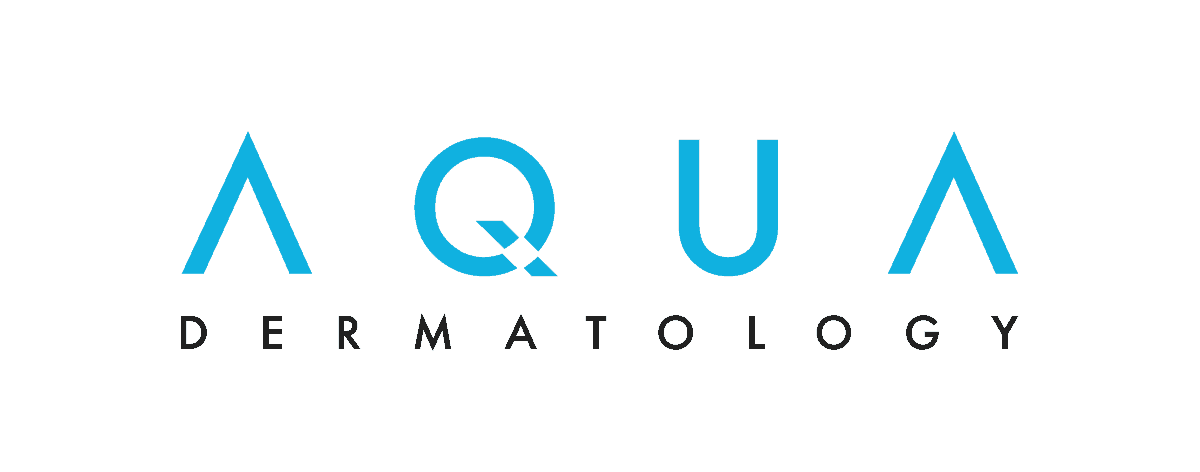Baby Acne: What Parents Need to Know

Acne is the bane of teenage life, but babies can get it, too, which often comes as a surprise to parents. Many newborns have baby acne (also called newborn acne or neonatal acne). Less often, babies develop acne as infants (infantile acne).
Baby acne is usually harmless and typically clears up on its own. Still, it’s important to know how to avoid aggravating the baby’s skin and when to bring your baby to a dermatologist to make sure the condition doesn’t require treatment.
What causes baby acne?
In most cases, newborn acne isn’t technically acne at all.
“Very early neonatal acne is more likely an inflammatory reaction to a yeast overgrowth,” said Robin Gehris, MD, a board certified adult and pediatric dermatologist at Riverchase Dermatology.
It may start when hormones passed on from the mother just before she gives birth stimulate the glands that produce sebum, the oily substance that can clog pores.
“Yeast that normally live on the skin, called Malassezia, flourish when sebum production increases in newborns. The yeast, in turn, creates inflammation that results in neonatal acne,” said Dr. Gehris. “The condition is better termed neonatal cephalic pustulosis since the blackheads and whiteheads you see with true acne aren’t present,” she added.
Neonatal cephalic pustulosis (NCP) may appear when babies are about two or three weeks old and typically peaks at four to six weeks.
What causes infant acne?
“Infantile acne is more what we consider to be true acne,” said Dr. Gehris. It’s much less common than newborn acne, occurring in less than 2% of infants. Babies who develop infant acne usually get it when they are several months old.
The causes are unknown, but genetics may play a role. In some babies, the sebum-producing glands are overactive despite normal levels of androgens, the so-called “male” sex hormones. These hormones are a major factor in adult acne.
What does baby acne look like?
Acne can look different in newborns and infants.
Signs of baby acne
Newborn acne (NCP) can appear as small, greasy, red-pink pimples or red or white pustules (bumps filled with pus) and may include a rough, bumpy rash. Blemishes usually develop on the cheeks, though they can also appear on the nose, eyelids, forehead, chin, scalp, neck and upper torso. NCP does not normally cause blackheads or whiteheads.

This baby has neonatal cephalic pustulosis, often called baby acne.
Newborn acne is sometimes confused with baby milia. These small, pearl-like white or yellowish bumps are very common in newborns. One difference between baby acne and milia is the texture: Milia are firmer. They also tend to be tiny (almost the size of a pinhead), and they contain a white plug, whereas newborn acne looks pink, greasy and inflamed.
Infant acne symptoms
Infant acne looks more like adult acne. You might see whiteheads and blackheads in addition to solid bumps (papules or nodules) and pustules. Infant acne usually affects the face but can sometimes appear on the chest and back.
When does baby acne go away?
While newborn acne usually goes away on its own in a matter of weeks or months, infant acne can take six to 12 months or more to clear. In some babies, the acne may cause scars if it isn’t treated.
When should baby acne be treated?
If your newborn has acne, bring the baby to a dermatologist if the condition hasn’t improved after several weeks.
“While NCP can resolve on its own, seeing a pediatric dermatologist can be helpful,” said Dr. Gehris. “We can recommend topical therapy to help it resolve faster. We can also make sure it isn’t true infantile acne, which would also require therapy.”
Infant acne is a different story.
“Infant acne does not always resolve on its own and deserves medical attention from a pediatric dermatologist,” said Dr. Gehris. “Failure to treat it, especially if inflammatory lesions are present, can result in scarring.”
Since infant acne is uncommon, the doctor will want to make sure the symptoms aren’t caused by another issue, such as baby eczema or a skin infection. Rarely, infant acne can be a sign of an endocrine disorder.
Baby acne treatment
If your newborn has NCP, the dermatologist may prescribe a topical anti-yeast cream.
If your baby has true acne and the dermatologist decides it should be treated, they may prescribe a topical acne medicine or, if the acne is severe, an antibiotic.
Never use any acne treatment or acne wash on your baby unless the baby’s dermatologist recommends it. Acne products intended for teens and adults may be too harsh for babies.
How should I care for my baby’s acne at home?
A baby’s skin needs gentle care. To care for a baby with acne:
- Wash the affected area daily. Use plain water, or alternate between plain water and a gentle, unscented cleanser. Don’t scrub. Lightly pat the skin dry with a towel instead of rubbing it dry.
- Don’t use oily or greasy skin care products on areas with acne. These could make the acne worse.
- Refrain from picking at the acne. Picking at or popping pimples can aggravate the acne and lead to infection.
Medically reviewed by Robin Gehris, MD
Written by Jessica Brown, a health and science writer/editor based in Nanuet, New York. She has written for Water’s Edge Dermatology, Prevention magazine, jnj.com, BCRF.org, and many other outlets.


